 |
 Leyte Leyte - The Largest Naval Battle in WWII |
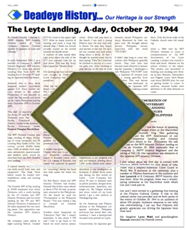 |
| Dencker's Article about Leyte in the Deadeye Dispatch |
|
Dencker landed on Leyte October 20, 1944 opposed by the Japanese where they changed their tactics. He was a rifle man in a foxhole.
|
Don says, "Many difficult times, nearly daily. You just had to to keep on going and you hope you would make it, what you did was just pray and carry out your duty."
|
Don tells the Foxhole Story
|
"One day we were holding out our positions. Hallister, loud artiliery was 150 yards short, the 2nd came and landed 75 yards. And I made an imaginary line, went right through my foxhole, the next one hit and we were right through, 3rd shell hit , so that's one of the worst incidents in my life." I was pretty scared and we did our job, there were thousands of casualties. It was always hard."
|
|
Dencker described Leyte as a green hell because of the jungles and the rain. "It rained and rained and rained, and my fatigue uniform practically rotted off me," he said. "That wasn't unusual." In addition, many developed a skin disease they called "Jungle Rot."
The mission of the 96th Infantry Division, commanded by Maj. Gen. James L. Bradley, was to clear the most prominent terrain feature in the entire Sixth Army landing zone, Catmon Hill. Bradley's troops made their way through the swamps south and west of the high ground. The battle of Leyte was the first to experience attacks from Kamakaze pilots.
|
 |
 Okinawa - The Battle of Okinawa was the last great battle of WWII Okinawa - The Battle of Okinawa was the last great battle of WWII |
| |
|

Don Dencker, just after completing his service in the US Army
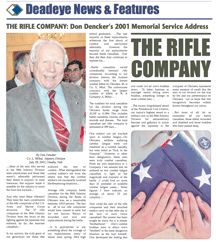
Deadeye article about the Rifle Company |
Dencker served in Rifle company L (Love Company) fighting during the Battle of Okinawa from April until July.
During that time, the 96th Infantry Division, which was largely a division of draftees, participated in two major battles: The Battle of Leyte, Philippines, and the Battle of Okinawa, Japan.
Dencker was 19 years old at the Battle of Leyte, and 20 years old at the Okinawa. |
| The 96th Infantry Division was an Army Amphibious Division, Dencker said. "I guess we were the Army's marines," he said. |
| "I made the amphibious landing on Leyte, Philippines, on Oct. 20 1944. And the amphibious landing on Okinawa, Japan on April 1, 1945, which was the Easter Sunday actually," |
Dencker said. "We had a tremendous number of casualties on Okinawa, and we had a fair number on Leyte."
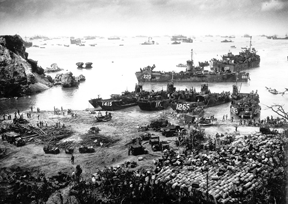
Go to this page on the 96th Infantry website to read Don's excellent article about his first hand account of the Battle of Okinawa. LINK |
| |
"Okinawa was, I would say, as tough as any battle in the pacific because the Japanese didn't try to stop us at the beach because they figured they couldn't do it," he said. "They were waiting for us in prepared positions with interlocking fields of fire on ridgelines that ran across the island. They concentrated their defense in the southern third of the island of Okinawa, and they also had the largest concentration of artillery, mortars and machine guns, that were encountered by American forces in the Pacific. So Okinawa was a terrible battle, actually."
|
|
| |
|
 |
Don was in a rifle company, which were the soldiers up at the front lines meeting the enemy head on. He used the .30 Carbine rifle, which was designed to be "more of a pistol, but less than a rifle."
Company L was familiarly called "Love Company" during WWII, therefore Don's book about his wartime experiences is named Love Company.
|
The .30 Carbine cartridge was designed by Winchester for the military in the early 1940s.
|
| |
|
| Retrospective Account of Don in Okinawa |
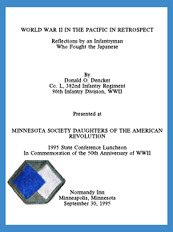
|
On the left is another Retrospective look of Dencker's wartime experience in the 96th Infantry Division
His audience was the Daughters of the American Revolution Society.
|
|
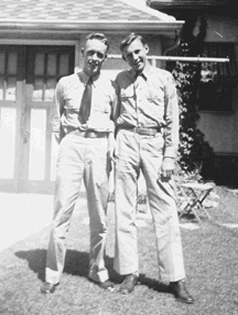 |
| Don Dencker and an Army buddy Bob Kelly standing in front of the Kelly home where they were on leave. |
|
| From the above Retrospective Speech |
"This talk is dedicated to my comrades of the 96th Infantry Division, U.S. Army, Ever etched in my mind is my buddy Tony Nicholo. My last conversation with Tony was November 20, 1944 during combat on Leyte Island in the Philippines. Tony said, “Those guys that got hit today were lucky. I have a feeling that when I get hit it will be bad.” (Co. L had 3 men hit by Japanese machine gun fire in the legs that day) The next day I saw Tony dead, a Japanese bullet through his heart."
God Bless the Filipinos on Leyte for remembering us so well.
Where else in the world can an American G.I. Walk on a beach and be hailed as “Joe” by a 10 year old kid?
|
| |
| M4 Sherman Tank |
Apple Ridge Battle Okinawa 1945 |
|
"By the Grace of God, I was one of seven that had been there every day and wasn't killed or wounded," Don said. |
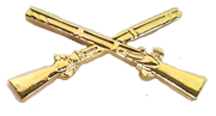 |
He was on Okinawa, when the whole division shipped out to Mindoro for rest and rehabilitation. |
| |
| This is one of two 96th Division Cemeteries in Okinawa. |
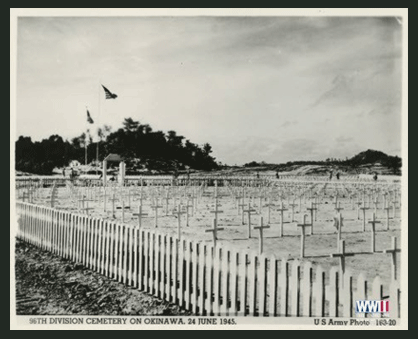 |
US battle casualties on Okinawa exceeded 3900 American men and Japanese military killed was about 90,000 individuals.
|
Click HERE for Battle Statistics provided by 96th Infantry Deadeye Historian, Don Dencker
|

